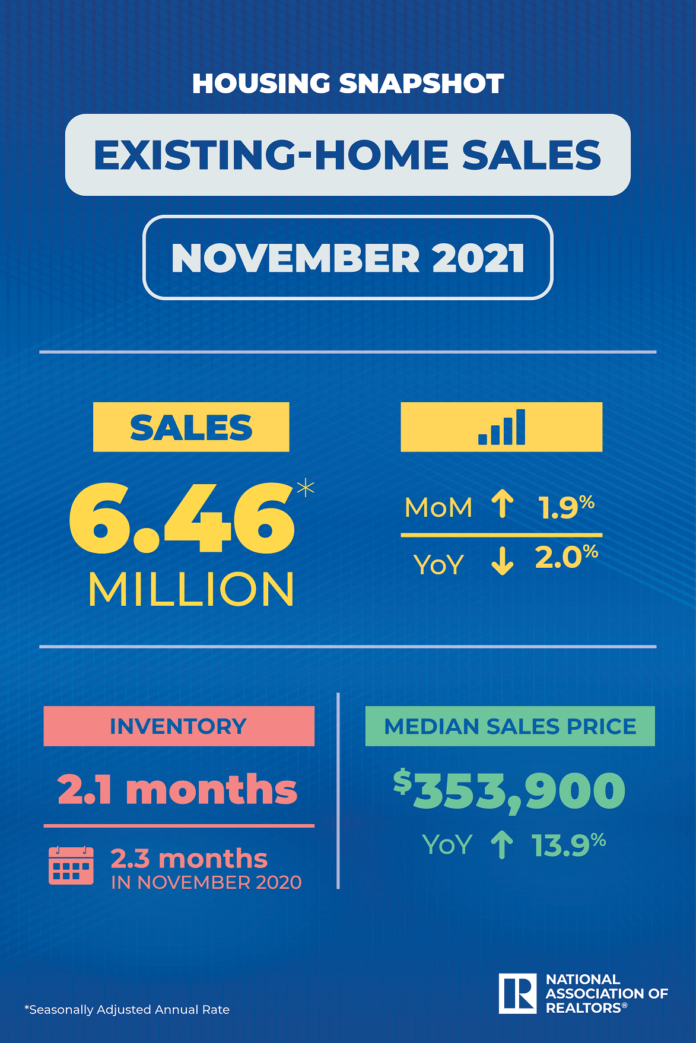Existing-home sales rose in November, denoting three consecutive months of increases, according to the National Association of Realtors. Three of the four major U.S. regions reported growth in monthly sales, while the fourth region held steady in November. From a year-over-year perspective, only one region experienced a rise in sales as the three others saw home sales decline.
Total existing-home sales – completed transactions that include single-family homes, townhomes, condominiums and co-ops – grew 1.9% from October to a seasonally adjusted annual rate of 6.46 million in November. Sales fell 2.0% from a year ago (6.59 million in November 2020).
“Determined buyers were able to land housing before mortgage rates rise further in the coming months,” says Lawrence Yun, NAR’s chief economist. “Locking in a constant and firm mortgage payment motivated many consumers who grew weary of escalating rents over the last year. Mortgage rates are projected to jump in 2022; however, I don’t expect the imminent increase to be overly dramatic.”
Yun forecasts the 30-year fixed mortgage rate to average at 3.7% by year-end 2022.
Total housing inventory at the end of November amounted to 1.11 million units, down 9.8% from October and down 13.3% from one year ago (1.28 million). Unsold inventory sits at a 2.1-month supply at the current sales pace, a decline from both the prior month and from one year ago.
The median existing-home price for all housing types in November was $353,900, up 13.9% from November 2020 ($310,800), as prices increased in each region, with the highest pace of appreciation in the South region. This marks 117 straight months of year-over-year increases, the longest-running streak on record.
“Supply-chain disruptions for building new homes and labor shortages have hindered bringing more inventory to the market,” adds Yun. “Therefore, housing prices continue to march higher due to the near-record-low supply levels.”
Yun noted that inflation and the pace of price appreciation are expected to subside next year. Last week, NAR held its third annual Real Estate Forecast Summit, featuring economists and housing experts whose consensus found inflation would likely ease in 2022 at a 4% rate, while home prices are expected to rise at a moderate pace of 5.7%.
Properties typically remained on the market for 18 days in November, equal to October and down from 21 days in November 2020. Eighty-three percent of homes sold in November 2021 were on the market for less than a month.
First-time buyers were responsible for 26% of sales in November, down from 29% in October and from 32% in November 2020. NAR’s 2021 Profile of Home Buyers and Sellers – released last month – reported that the annual share of first-time buyers was 34%.
Individual investors or second-home buyers, who make up many cash sales, purchased 15% of homes in November, down from 17% in October and up from 14% in November 2020. All-cash sales accounted for 24% of transactions in November, equal to October’s percentage, and up from 20% from November 2020.
Distressed sales – foreclosures and short sales – represented less than 1% of sales in November, equal to the percentage seen a month prior and equal to November 2020.
According to realtor.com’s Market Trends Report, the markets seeing the largest year-over-year growth in newly listed homes include Milwaukee (+17.4%), Charlotte (+16.1%) and Buffalo (+13.5%). Markets still seeing a decline in newly listed homes compared to last year are Hartford (-20.2%), San Francisco (-19.1%) and San Jose (-16.2%).
According to Freddie Mac, the average commitment rate for a 30-year, conventional, fixed-rate mortgage was 3.07 in November, equal to October’s rate. The average commitment rate across all of 2020 was 3.11%.
Single-family home sales rose to a seasonally adjusted annual rate of 5.75 million in November, up 1.6% from 5.66 million in October and down 2.2% from one year ago. The median existing single-family home price was $362,600 in November, up 14.9% from November 2020.
Existing condominium and co-op sales were recorded at a seasonally adjusted annual rate of 710,000 units in November, up 4.4% from 680,000 in October and equal to one year ago. The median existing condo price was $283,200 in November, an annual increase of 4.4%.
“As the year comes to an end, NAR is very proud of the work we’ve done to protect homeownership and the valuable investments made in our communities and infrastructure,” states NAR President Leslie Rouda Smith, a realtor from Plano, Texas, and a broker associate at Dave Perry-Miller Real Estate in Dallas. “We recognize that further efforts are needed and will continue to promote fair housing, work to increase the housing shortage, and fight to dismantle discriminatory housing laws and outdated policies.”
Existing-home sales in the Northeast were flat compared to the prior month, neither climbing or falling in November, and recorded an annual rate of 760,000, which is an 11.6% decrease from November 2020. The median price in the Northeast was $372,500, up 4.7% from one year ago.
Existing-home sales in the Midwest ticked up 0.7% to an annual rate of 1,520,000 in November, a 0.7% drop from a year ago. The median price in the Midwest was $260,100, a 9.0% jump from November 2020.
Existing-home sales in the South grew 2.9% in November, registering an annual rate of 2,850,000, a rise of 1.1% from one year ago. The median price in the South was $318,900, an 18.4% surge from one year prior.
Existing-home sales in the West increased 2.3%, reaching an annual rate of 1,330,000 in November, down 3.6% from one year ago. The median price in the West was $507,200, up 8.4% from November 2020.











